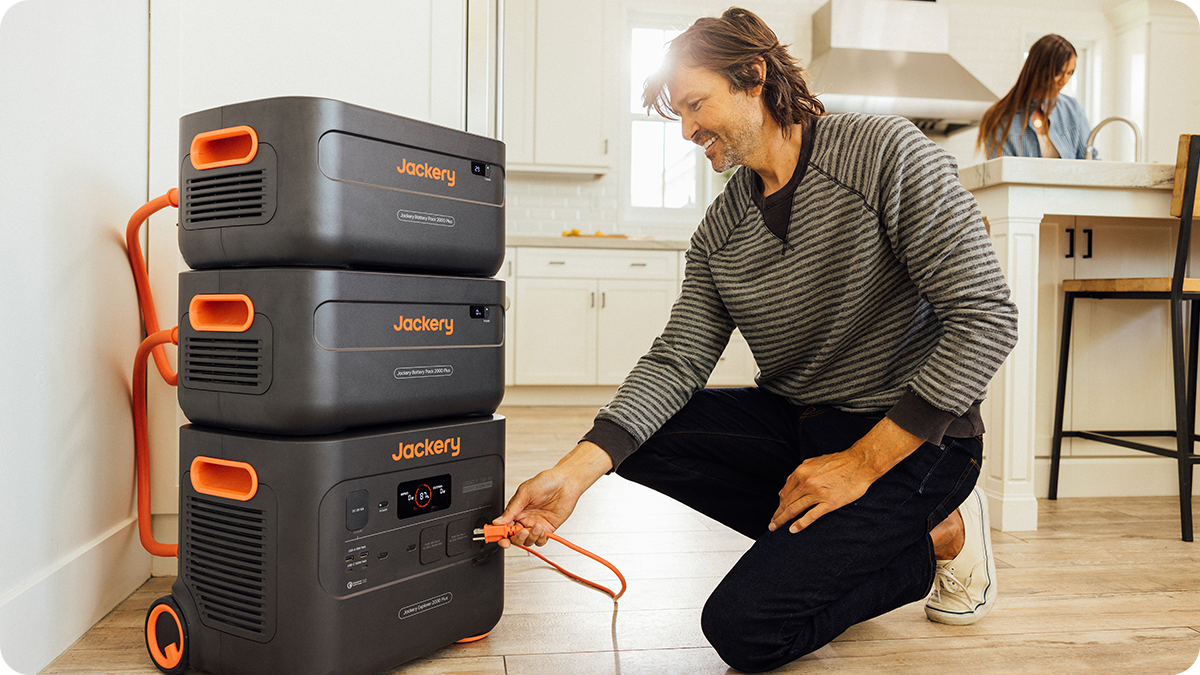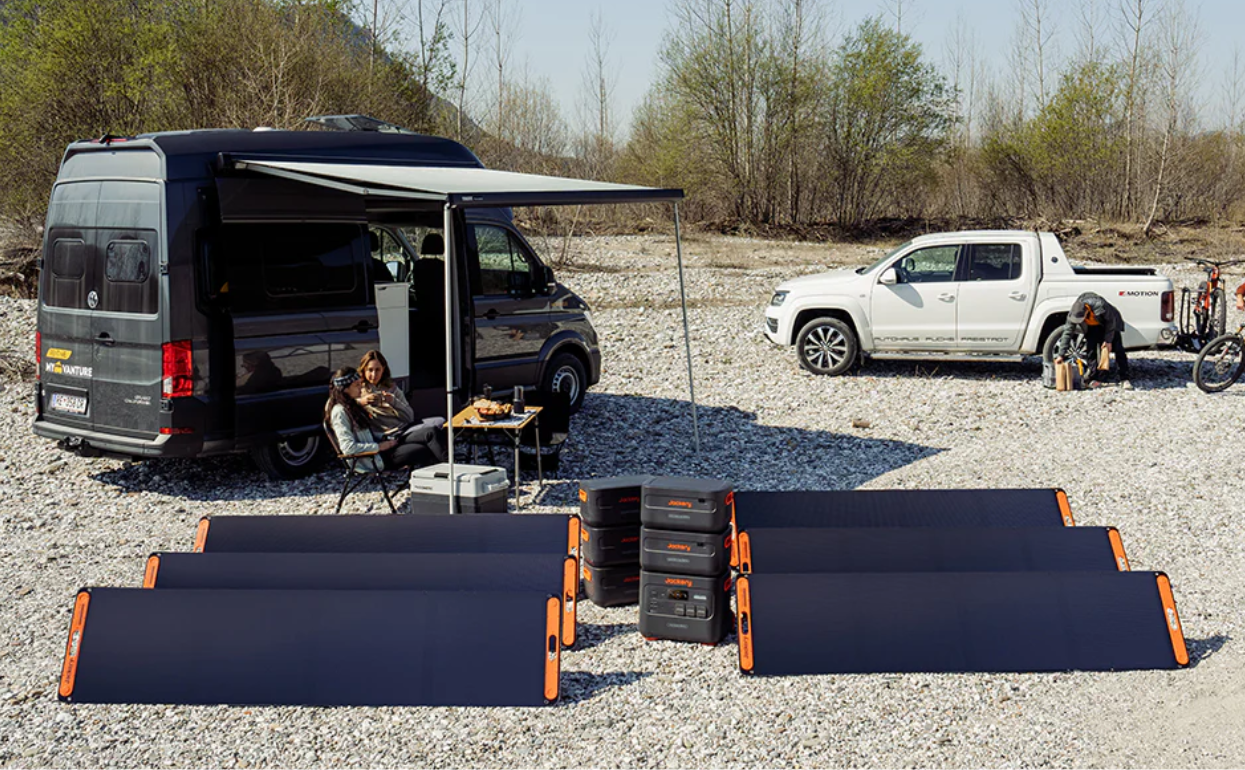Europe is witnessing a significant surge in off-grid living, with thousands of homeowners prioritising energy resilience over traditional energy consumption. Researchers have estimated that by 2050, nearly 2 million European households might abandon the electrical grid entirely.[1] Most of these homeowners will rely on solar energy for their homes. Off-grid living isn't just for permanent residences but is also becoming a trend among travellers, campers, and remote workers. However, in order to have a successful off-grid living experience, especially with an off-grid power station or a solar-powered generator, you must understand your actual power requirements.
This guide will enable you to calculate your exact energy needs and help you select the ideal off-grid power solutions for your home and outdoor use.
Assess Your Daily Energy Consumption
Before you can select an off-grid power station, you must have a better understanding of how much power your home or your outdoor setup will utilise. This means you must list every device you plan to power through your off-grid power station. Assessing your daily energy consumption is, in fact, the first step to seamless off-grid living.
Before choosing an off-grid power station, it’s essential to understand how much power your home or outdoor setup will actually consume. Start by listing every device you intend to power with the station. Accurately assessing your daily energy usage is the first—and most critical—step toward a reliable off-grid experience.
To do this effectively, use the following formula:
Energy (Wh) = Power (W) × Hours Used per Day
It helps you determine how many hours each device will be used per day and how much power it consumes, allowing you to calculate its total energy demand. By doing this for each appliance, you’ll get a clear picture of your total daily energy consumption.
You can usually find the power rating on the label of each device, while the usage hours will depend on your habits.
Here is a quick rundown of the general appliances that a household in Europe may use (e.g., lights, fridge, laptop, and fan), and their total estimated energy consumption:
Typical Power Consumption of Common Appliances
|
Device |
Power (W) |
Hours used |
Energy (Wh) |
|
LED light bulbs (x4) |
40 (10 W each) |
6 |
240 |
|
Laptop |
65 |
8 |
520 |
|
Smartphone charger |
15 |
2 |
30 |
|
Tablet |
25 |
4 |
100 |
|
Mini refrigerator |
150 |
8 |
1200 |
|
Heater |
1000 |
2 |
2000 |
|
Coffee maker |
800 |
0.30 |
240 |
|
Wi-Fi router |
20 |
24 |
480 |
Table 1: Power Consumption of Common Appliances
Here, you can calculate the total energy consumption as = 4810 Wh.
It may seem minimal, but devices like a smartphone, laptop, lighting, and a heater can quickly push your daily energy demand beyond 3,000 Wh. This highlights the importance of having a properly sized off-grid power station.
Keep in mind these are just estimates, and actual energy use can vary from one household to another. We are only listing the general appliances that you can expect to find in our home.
Calculate Total Daily Power Consumption in kWh
Now that you have identified all the necessary devices that you will run in your home, whether it's your permanent residential property or your RV while on the road, you are one step closer to finding the ideal off-grid power station. The next step involved converting the energy consumed in watts (W) to kilowatt-hours (kWh)—the standard unit of measurement for energy capacity in off-grid power stations.
Finding this value for your home needs is actually quite simple. Here is the formula to use:
Total Daily Energy (kWh) = Total Wh ÷ 1,000
This means you must only take our previously calculated value and divide by 1,000. In our scenario, this will be:
Total Daily Energy (kWh) = 4810 ÷ 1,000
Total Daily Energy = 4.81 kWh
Therefore, the off-grid power station you bring in must have the capacity to store and deliver a minimum of 4.81 kWh.

Size of the Off-grid Power Station
To determine the right battery capacity, you need to go beyond theoretical numbers and account for real-world factors, such as energy loss during storage and conversion, battery discharge limits, and your daily usage patterns. Considering these practical inefficiencies ensures your off-grid power station can reliably meet actual energy demands.
Factors to Consider
- Battery efficiency
Battery efficiency refers to the percentage of stored energy that can actually be utilised. Most modern off-grid power stations utilise lithium batteries with efficiency rates ranging from 90% to 95%. For example, a 1000 Wh lithium battery typically delivers 900 to 950 Wh of usable power, higher than traditional lead-acid batteries, which often fall below 85%.
- Depth of discharge (DoD)
Depth of discharge (DoD) indicates how much of a battery’s total capacity has been used. For instance, if a fully charged battery drops to 50%, its DoD is 50%.
Higher DoD levels place more stress on the battery, increasing internal resistance and accelerating wear. To extend battery lifespan, it’s best to keep DoD within a safe range—typically between 20% and 85%.
- Days of autonomy
Finally, consider your days of autonomy. This is the number of days you expect to operate your off-road power station without recharging via the solar panels or the grid. This is particularly important for European countries in the north, where winter months tend to limit direct sunlight availability for extended periods. As such, many homeowners may need to recharge their off-grid system using alternative means. Ideally, your off-grid system requires 2 to 3 days of autonomy.
A more convenient way to calculate the best sizing for your off-grid system or the required "battery capacity" is to use the following formula:
Battery Capacity (kWh) = Daily Energy × Days of Autonomy ÷ (DoD × Efficiency)
Let's calculate the required battery capacity by using our previous example, where the daily power requirements were 4.81 kWh per day.
- Daily Energy: 4.81 kWh
- Days of Autonomy: 3 days
- Depth of Discharge: 80%
- Battery Efficiency: 90%
Therefore,
Battery Capacity = 4.81 × 2 ÷ (80% ×90%) = 13.36 kWh
This means that the off-grid system you acquire must be able to provide at least 13.36 kWh to support a 3-day autonomy period.
Real-World Example: Weekend Cabin
In case you were to take a weekend trip to a cabin, this battery capacity might appear somewhat different. Let's run a quick calculation to assess how the energy needs might differ.
Here is a table that showcases the typical appliances you might use on your weekend getaway.
|
Device |
Power (W) |
Hours Used |
Energy (Wh) |
|
LED lights (x3) |
30 (10 W each) |
6 |
180 |
|
Smartphone charger |
15 |
2 |
30 |
|
Camera |
25 |
1 |
25 |
|
Laptop |
65 |
2 |
130 |
|
Electric kettle |
1200 |
0.5 |
600 |
|
Electric stove |
1800 |
1 |
1800 |
|
Coffee maker |
800 |
0.30 |
240 |
|
Mini refrigerator |
150 |
8 |
1200 |
|
Total |
- |
- |
4205 |
Table 2: Appliance power usage for weekend getaway
Total energy consumption= 4205 Wh or 4.205 kWh
For 3 days of autonomy: Battery Capacity = 4.205 × 3 ÷ (0.8 × 0.9) = 17.52 kWh.
Estimate Solar Input or Charging Needs
As demonstrated by our examples above, you will need an expansive off-grid power solution to support your off-grid living. The best solution here is to invest in a solar power generator. However, solar output tends to vary depending on your location and the type of device you are operating. Here are the factors you must consider when making your choice:
Sunlight hours
In most areas of Europe, typically in the north, you won't receive as many sunlight hours. In northern Europe, especially during winter, sunlight hours can be as low as 1 to 2 hours per day, while southern regions typically enjoy 6 to 8 hours or more. Keep in mind that the more sunlight hours, the more energy your system can produce.
Panel efficiency
The panel efficiency of your solar-powered device refers to the amount of energy it can produce relative to the amount of sunlight striking it. You might be surprised to learn that even the most modern solar panels only convert about 18 to 22% of available solar energy into electricity, with a few models reaching up to 25% efficiency.
System losses
You must also factor in system losses, which are the natural losses that your solar system will experience due to temperature effects, shading, dust and natural resistance. Around 10 to 15% of all energy tends to be lost in this manner.
According to the factors mentioned above, we can devise a formula for the ideal solar generator capacity you should be aiming for:
Solar Panel Output (kW) = Daily Energy Need (kWh) ÷ (Peak Sun Hours × System Efficiency)
To better understand this, let's compare two regions in Europe, one experiencing a sunny day in the South and one experiencing a cloudy day in the north.
|
Location |
Peak Sun hours |
Daily energy needs (kWh) |
System Efficiency |
|
A (Sunny) |
5 |
4kWh |
80% |
|
B (Cloudy) |
1.5 |
4kWh |
80% |
Table 3: Solar energy comparison: sunny vs. cloudy Europe
For A,
Solar Panel Output (kW) = 4 ÷ (5 × 0.80) = 1 kW
For B
Solar Panel Output (kW) = 4 ÷ (1.5 x 0.80) = 3.33 kW
This shows that as peak hours reduce, even with constant usage, you will need a much larger solar panel output to meet energy needs. For the same reason, your existing system for summer may prove inadequate during winter.
Choose the Right Off-grid Power Station
With your energy needs clearly calculated, it’s time to find an off-grid power station that meets those requirements while fitting your lifestyle and budget.
Power Station Capacity
To pick the right solar power station, you need to know two things: your daily energy use (in kWh) and your peak power demand (in W).
The energy capacity (Wh) tells you how long the power station can keep your devices running. The power demand (W) shows how much power it can supply at one time.
For example, even if a unit has a 3,000 Wh capacity, if its power output is only 1,000 W, it won’t be able to run heavy equipment that needs more power all at once.
Besides, portable power stations are typically categorised by their battery capacity, measured in watt-hours (Wh). This capacity indicates how much energy the unit can store and supply before needing a recharge. Generally, there are three tiers:
- Under 500Wh, best for minimal use, typically as a backup power solution.
- 500–1500Wh, suitable for short stays over the weekend or for digital nomads who are on the move.
- 1500Wh and above, perfect for use in cabins or remote sites to fully power all necessary appliances.
Inverter Size
The inverter size indicates the maximum continuous power (in watts) the unit can convert from DC to AC at any given time. Without a properly sized inverter, your solar power can’t be used effectively.
Number of Output Ports
You’ll often need to power several devices at once, so it’s best to choose an off-grid power station with a variety of output options, including USB ports, AC outlets, and DC outlets, to keep everything connected.
Recharging Options
Europe isn’t always sunny, so solar panels won’t always fully recharge your power station. Alternative charging options, like via a wall outlet, are essential to keep your system powered.

Go for Jackery Portable Power Stations
Jackery is proud to be a trusted name in Europe for green energy solutions. Our portable power stations offer reliable, convenient options for anyone exploring off-grid living. Not sure which model suits your needs best? Take a look at our helpful recommendations below to find the perfect fit.
Jackery Explorer 2000 v2 Portable Power Station
For those embracing off-grid living across Europe, the Jackery Explorer 2000 v2 Portable Power Station strikes the balance between powerful performance and easy portability.

- Massive Capacity to Power Your Life
With 2042Wh capacity and 2200W peak output, this portable power station runs high-demand appliances like refrigerators, coffee makers, and power tools. Say goodbye to power limits and interruptions—enjoy comfort and productivity anywhere.
- Lightweight and Compact for True Portability
Thanks to advanced LiFePO4 battery technology and innovative CTB design, it’s 35.6% lighter and 41% smaller than industry standards—just 17.5 kg, about the weight of a suitcase. It’s perfectly sized to fit in your car trunk or campervan, making it ideal for European road trips, weekend getaways to a remote cabin, or moving around your property with ease.
- Multiple Fast Charging Options for Ultimate Flexibility
Charge from wall outlets, solar panels, your car, or activate Emergency Super Charge via the app for a full battery in just 1.33 hours. Whether you’re parked at a campsite in the French countryside or powering your home during an outage, staying charged and ready has never been simpler.
Jackery Explorer 3000 v2 Portable Power Station
Designed for those who need more than just backup, the Jackery Explorer 3000 v2 Portable Power Station brings serious energy for home, work, and off-grid life.

- Robust Capacity for Power-intensive Tasks
With 3600W output (7200W peak) and 3072Wh capacity, it can handle heavy-duty tools, electric grills, or ovens with ease. Perfect for home improvement projects, workshops, or outdoor events that demand reliable high-wattage support.
- Smart Power Modes That Cut Bills
With solar-priority charging, off-peak scheduling, and intelligent battery management via the app, it helps reduce grid reliance and optimise energy use, potentially saving you up to 45% on electricity bills over time.
- Multiple Ways to Charge Quickly
The Jackery Explorer 3000 v2 Portable Power Station offers versatile recharging options, including wall outlets, solar panels, and car ports. You can get a full charge in just 1.4 hours using dual input (AC + 54V DC), or in 1.8 hours via standard wall charging.
Conclusion
Off-grid living and energy independence are becoming increasingly popular across Europe, offering freedom and sustainability. Understanding your daily power needs and carefully sizing your off-grid power station are essential steps to ensure reliable, uninterrupted energy wherever life takes you.
Whether you’re camping, living in a remote cabin, or embracing van life, Jackery’s portable power stations provide versatile, powerful, and eco-friendly solutions tailored to your lifestyle. The Jackery Explorer 2000 v2 Portable Power Station and Jackery Explorer 3000 v2 Portable Power Station combine powerful output, substantial battery capacity, and multiple charging methods to keep you powered on your terms.
Take the next step towards true energy independence—explore Jackery’s range and find the perfect off-grid power station to power your adventure and daily life with confidence.









